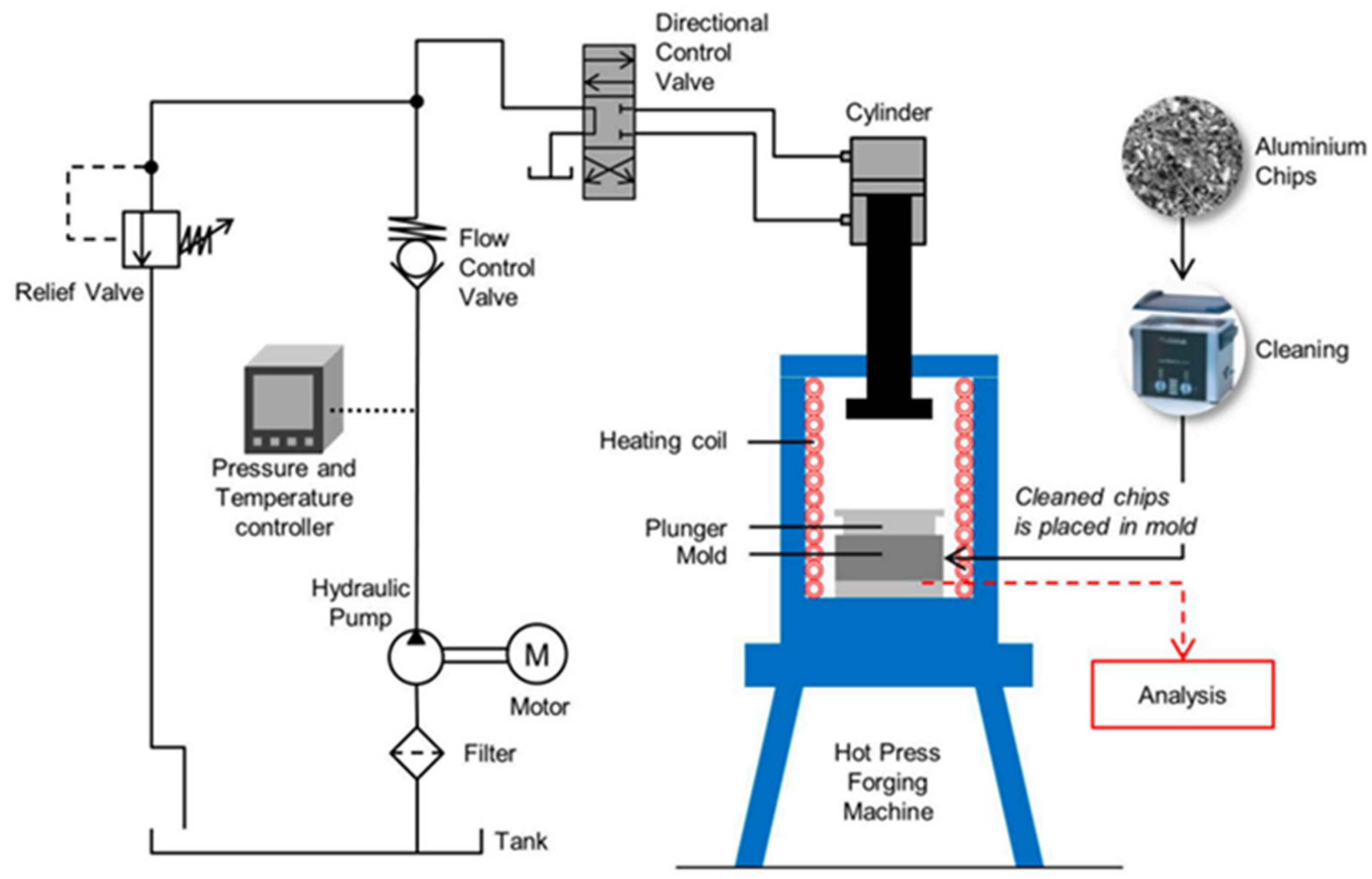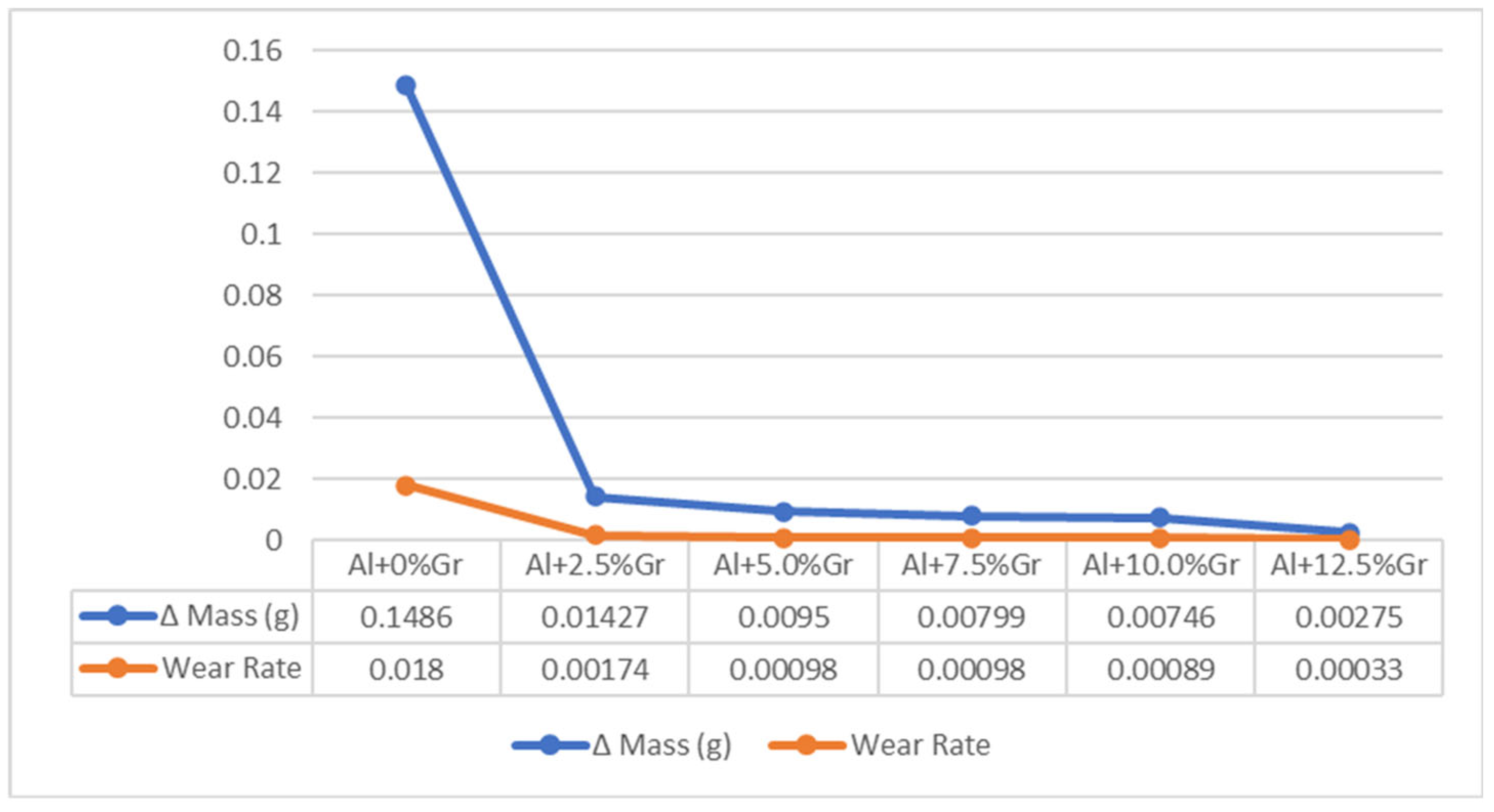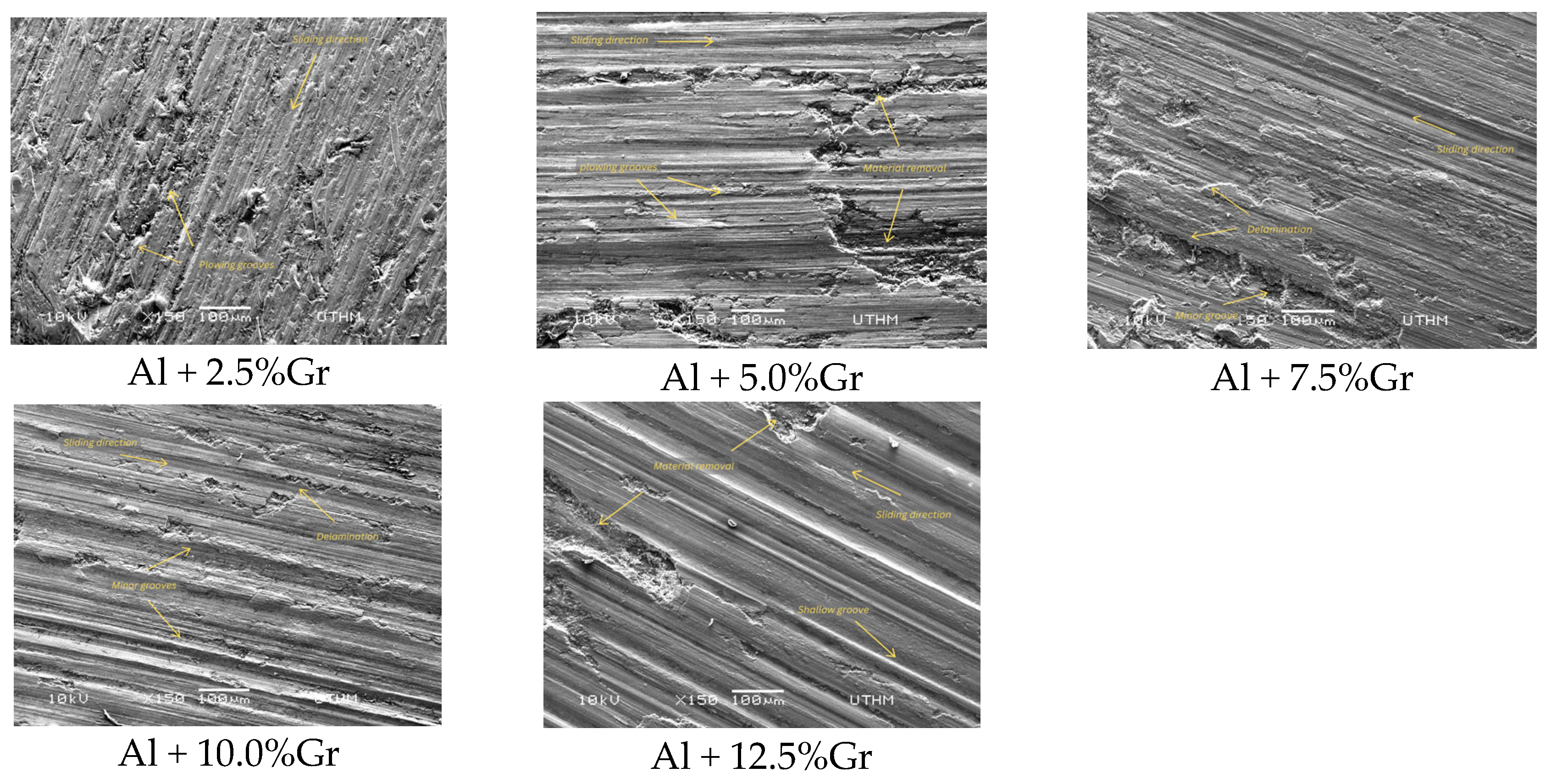Impact of Graphite on Aluminum Alloy 6061: Insights into Mechanical and Tribological Behavior Through Hot Press Forging †
Abstract
1. Introduction
2. Methodology
2.1. Materials Selection and Preparations
2.2. Characteristics and Mechanical Properties
3. Results
3.1. Tensile and Yield Strength Behavior in Graphite-Reinforced Aluminum Composites
3.2. Microhardness Behavior in Graphite-Reinforced Aluminum Composites
3.3. Wear Behavior
3.4. Wear Mechanism
4. Conclusions
Author Contributions
Funding
Institutional Review Board Statement
Informed Consent Statement
Data Availability Statement
Conflicts of Interest
References
- Khaireez, M.A.; Abdullah, N.A.; Hassan, M.H. Analysis of tribological properties of graphite-reinforced AA6061 composites. J. Tribol. Res. 2020, 15, 123–130. [Google Scholar]
- Somayaji, V.; Kumar, S.R.; Uday, M.B. Effect of reinforcement on mechanical properties of MMCs. Adv. Compos. Mater. 2018, 12, 45–52. [Google Scholar]
- Fogagnolo, J.B.; Velasco, F.; Robert, M.H.; Torralba, J.M. Recycling aluminium alloy and aluminium matrix composites (MMCs) chips through powder metallurgy. J. Mater. Process Technol. 2006, 172, 399–408. [Google Scholar]
- Rady, M.H.; Mustapa, M.S.; Harimon, M.A.; Ibrahim, M.R.; Shamsudin, S.; Lajis, M.A.; Wagiman, A.; Msebawi, M.S.; Yusof, F. Effect of hot extrusion parameters on microhardness and microstructure in direct recycling of aluminium chips. Mater. Werkst. 2019, 50, 718–723. [Google Scholar] [CrossRef]
- Li, J.; Tang, Z.; Zhao, Y. Mechanical and wear behavior of graphite-reinforced aluminum composites. Wear 2015, 332, 788–796. [Google Scholar]
- Che Berhanuddin, N.I.; Mohd Rozlan, S.A.; Zaman, I.; Mustapa, M.S.; Abdullah, M.E.; Bahrudin, I.A. Effect of thermal expansion and sonication on mechanical properties and adhesive toughness measurement of polymer/graphene composite. In Materials Science Forum, Proceedings of the 5th International Conference on Engineering and Innovative Materials (ICEIM 2016), Kuala Lumpur, 10–12 September 2016; Trans Tech Publications: Zürich, Switzerland, 2017; Volume 889, pp. 14–18. [Google Scholar]
- Akhlaghi, F.; Niroumand, B. Wear and tribological performance of aluminum–graphite MMCs. Wear 2000, 250, 5–12. [Google Scholar]
- Nagarajan, G.; Singh, A.K.; Venkatesan, M. Mechanical properties of graphite reinforced aluminum composites: A review. Mater. Res. Express 2019, 6, 025303. [Google Scholar]
- Kumar, P.; Sharma, S.; Gupta, V. Characterization and mechanical properties of aluminum-graphite composites: A critical review. Mater. Today Proc. 2020, 26, 355–362. [Google Scholar]
- Lee, S.J.; Park, S.H.; Kim, S. Influence of particulate size on the properties of graphite-reinforced aluminum matrix composites. J. Compos. Mater. 2015, 49, 1301–1309. [Google Scholar]
- Kadir, M.I.A.; Mustapa, M.S.; Mahdi, A.S.; Kuddus, S.; Samsi, M.A. Evaluation of hardness strength and microstructures of recycled Al chip and powder AA6061 fabricated by cold compaction method. In IOP Conference Series: Materials Science and Engineering, Proceedings of the Colloquium of Advanced Mechanics, CAMS 2016, Batu Pahat, Johor, 18–19 December 2016; IOP Publishing: Bristol, UK, 2017. [Google Scholar]
- Vaidya, B.K.; Reddy, B.V.; Rao, S. The effects of graphite reinforcement on the mechanical properties of aluminum matrix composites. Compos. Sci. Technol. 2017, 148, 104–113. [Google Scholar]
- Li, M.; Kumar, M. Reinforcement of aluminum composites: A review on graphite and its properties. Mater. Sci. Eng. A 2019, 760, 149–158. [Google Scholar]
- Prasad, V.K.; Prakash, C.; Bhowmick, S. Effect of graphite addition on the mechanical properties of aluminum-based composites. J. Alloys Compd. 2018, 735, 509–516. [Google Scholar]
- Zhang, Y.; Zhang, L.; Wang, J. Effect of graphite content on the properties of aluminum-based composites. Mater. Sci. Eng. A 2020, 783, 139285. [Google Scholar]
- Shamsudin, N.; Muhamad, N.; Jamaludin, N.; Suhaimi, S. Sustainable recycling of AA6061 chips using hot press forging technique. In Green Manufacturing Processes and Technologies; John, D., Lee, K., Eds.; Springer: New York, NY, USA, 2018; pp. 115–130. [Google Scholar]
- Kumar, P.; Sharma, S. Enhancing the mechanical properties of aluminum composites using graphite as reinforcement. Compos. Part B Eng. 2018, 144, 177–185. [Google Scholar]





Disclaimer/Publisher’s Note: The statements, opinions and data contained in all publications are solely those of the individual author(s) and contributor(s) and not of MDPI and/or the editor(s). MDPI and/or the editor(s) disclaim responsibility for any injury to people or property resulting from any ideas, methods, instructions or products referred to in the content. |
© 2025 by the authors. Licensee MDPI, Basel, Switzerland. This article is an open access article distributed under the terms and conditions of the Creative Commons Attribution (CC BY) license (https://creativecommons.org/licenses/by/4.0/).
Share and Cite
Ravi, D.; Mustapa, M.S.; Ibrahim, M.R.; Yusof, Y.; Wahab, M.S.; Didane, D.H.; Siswanto, W.A.; Sarjito, S.; Wahyudi, B.; Andoko, A. Impact of Graphite on Aluminum Alloy 6061: Insights into Mechanical and Tribological Behavior Through Hot Press Forging. Eng. Proc. 2025, 84, 95. https://doi.org/10.3390/engproc2025084095
Ravi D, Mustapa MS, Ibrahim MR, Yusof Y, Wahab MS, Didane DH, Siswanto WA, Sarjito S, Wahyudi B, Andoko A. Impact of Graphite on Aluminum Alloy 6061: Insights into Mechanical and Tribological Behavior Through Hot Press Forging. Engineering Proceedings. 2025; 84(1):95. https://doi.org/10.3390/engproc2025084095
Chicago/Turabian StyleRavi, Darvinraj, Mohammad Sukri Mustapa, Mohd Rasidi Ibrahim, Yusri Yusof, Md Saidin Wahab, Djamal Hissein Didane, Waluyo Adi Siswanto, Sarjito Sarjito, Bagus Wahyudi, and Andoko Andoko. 2025. "Impact of Graphite on Aluminum Alloy 6061: Insights into Mechanical and Tribological Behavior Through Hot Press Forging" Engineering Proceedings 84, no. 1: 95. https://doi.org/10.3390/engproc2025084095
APA StyleRavi, D., Mustapa, M. S., Ibrahim, M. R., Yusof, Y., Wahab, M. S., Didane, D. H., Siswanto, W. A., Sarjito, S., Wahyudi, B., & Andoko, A. (2025). Impact of Graphite on Aluminum Alloy 6061: Insights into Mechanical and Tribological Behavior Through Hot Press Forging. Engineering Proceedings, 84(1), 95. https://doi.org/10.3390/engproc2025084095






